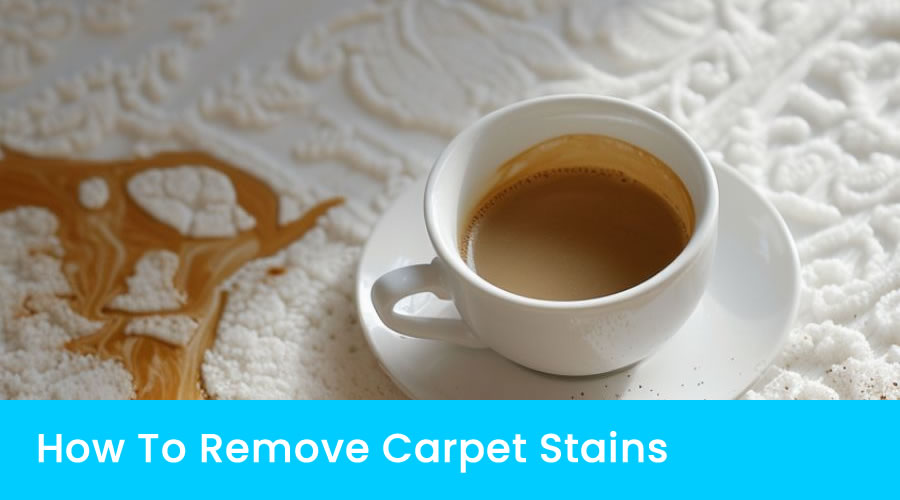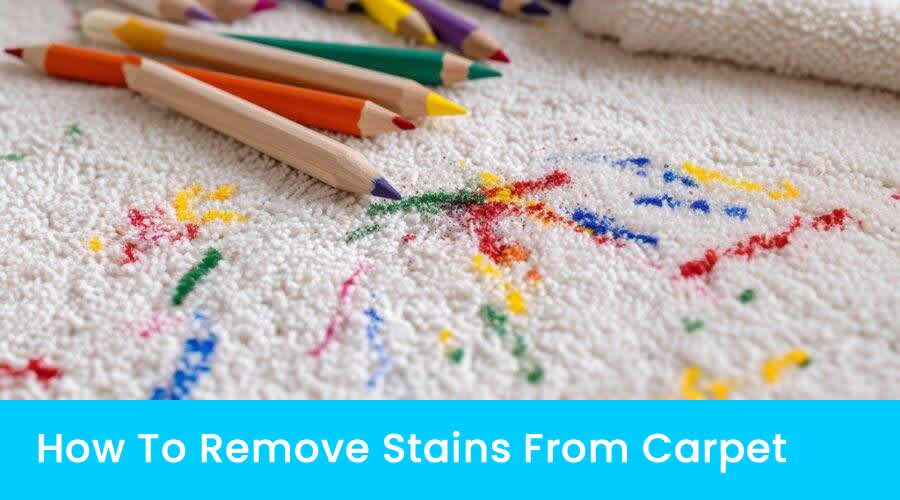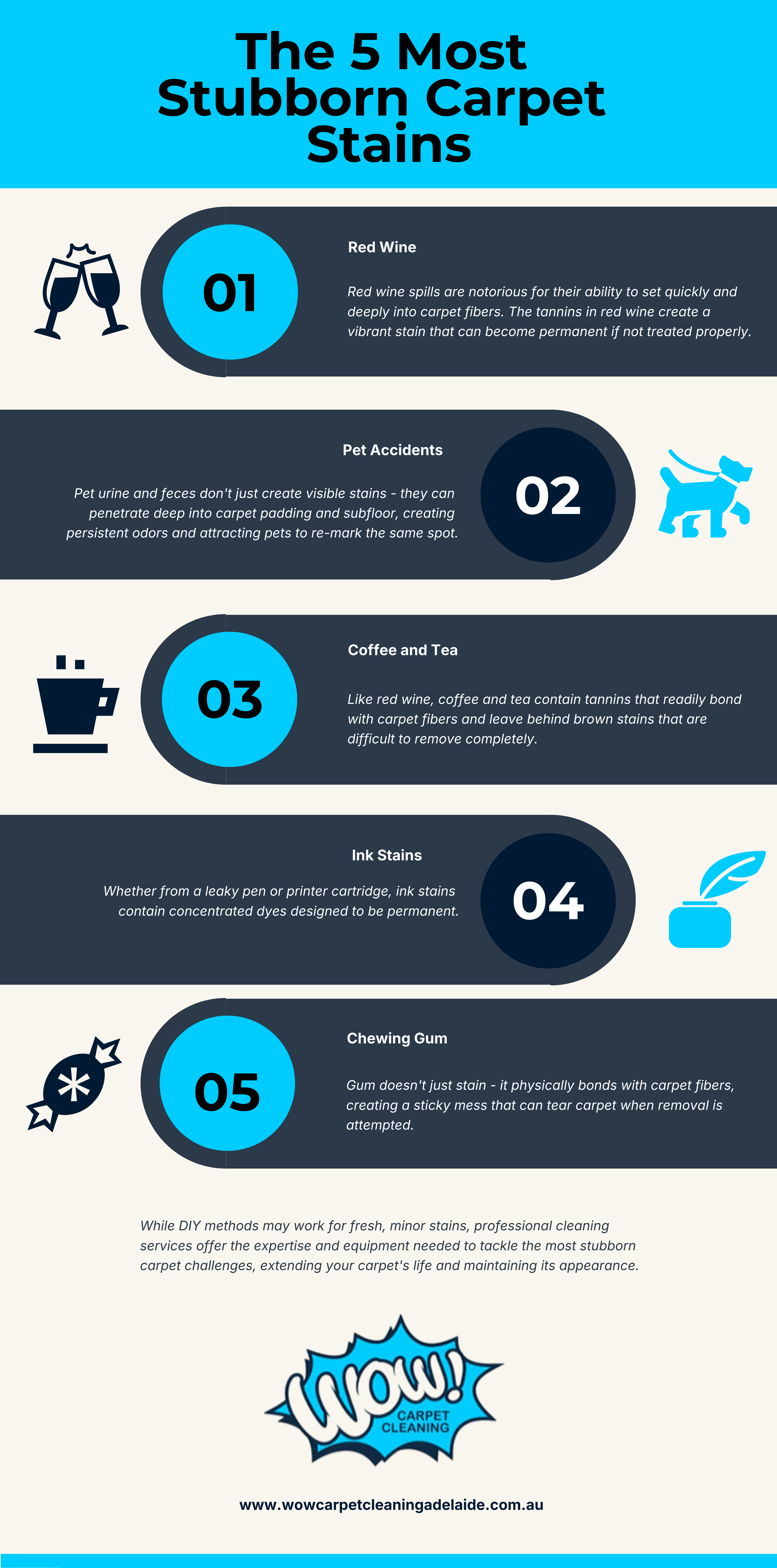How To Remove Carpet Stains
Carpet stains should be treated immediately to prevent permanent damage. Identify the stain before cleaning and choose a method suited to its type. Always blot, never rub, to avoid spreading or damaging fibres. Select a cleaning solution appropriate for the carpet and test it on a hidden area first to ensure it is safe.
This guide explains effective cleaning methods for removing stains and restoring your carpet’s appearance.
Carpet Stain Removal Techniques
Dish Soap and Warm Water
Mix one teaspoon of mild dish soap with one cup of warm water. Apply with a cloth, working from the outer edge of the stain inward. Blot gently and repeat until the spot is gone. Rinse with clean water to remove soap residue, as leftover detergent can attract dirt.
Vinegar and Water
Mix equal parts white vinegar and water in a spray bottle. Spray lightly onto the stain and wait 5–10 minutes. Vinegar breaks down many common stains and neutralises odours. Blot with a clean cloth until the soil lifts. Follow with a light rinse to remove any vinegar smell.
Baking Soda and Vinegar
For stubborn stains or smells, sprinkle baking soda directly over the area. Spray with a vinegar-water mix until it begins to fizz. Let it sit for 10–15 minutes to break down the stain and absorb odours. Once dry, vacuum thoroughly to remove the baking soda.
Hydrogen Peroxide
Best for light-coloured carpets and tough stains like wine or blood. Apply a small amount directly to the smudge and let it sit for up to 10 minutes. Blot with a cloth and rinse with water. Always test first, as peroxide can lighten fabrics.
Commercial Carpet Cleaners
When home methods fail, a professional-grade carpet cleaner can help. Choose a product designed for your carpet type. Read and follow instructions carefully to avoid damage.
How To Remove Stains From Carpet
1. Act Quickly
Speed is the most important factor in stain removal. The longer a mark sits, the deeper it soaks into the carpet backing. Liquids like coffee, wine, and juice can spread quickly through fibres. Once dried, they can cause permanent marks or discolouration.
As soon as you notice a spill, stop what you are doing and begin cleaning. For large spills, place a dry towel under the carpet if possible to stop the liquid from soaking into the underlay. This extra step reduces the risk of long-term odours or mould.
2. Blot, Do Not Rub
Blotting lifts the stain without forcing it deeper into the fibres. Use a clean white cloth or plain paper towel. White materials help you see the soil transfer and prevent colour bleeding.
Place the cloth over the area and press gently, allowing the fabric to absorb the liquid. Change cloths when they become saturated. Avoid quick scrubbing or circular motions-these can damage the pile, spread the stain, and make it harder to remove.
3. Identify the Stain
Choosing the right cleaning method depends on knowing what caused the discolouration. Different stains respond to different solutions.
- Food and drink spills (coffee, tea, juice, soft drinks): mild dish soap and warm water.
- Pet accidents: vinegar and water for odour removal and mild disinfection.
- Oily stains (butter, cosmetics, cooking grease): rubbing alcohol to dissolve oils.
- Protein-based stains (blood, milk, eggs): cold water and hydrogen peroxide.
- Mud and dirt: let dry, then vacuum before cleaning with soapy water.
If you are unsure of the stain’s origin, start with the mildest solution first.
4. Test the Cleaning Solution
Testing avoids accidental damage. Some cleaners can fade dyes or leave marks. Apply a small amount of the carpet stain remover to a hidden area, such as behind furniture or inside a wardrobe. Let it sit for five minutes, then blot and check for changes in colour or texture. If no damage is visible, proceed.
5. Rinse and Dry
After removing the stain, rinse the area with water to remove any residue. This is important because leftover cleaner can leave a sticky layer that attracts new dirt. Blot with dry towels until most of the moisture is gone. Avoid walking on the area until it is fully dry.
6. Vacuum to Restore Fibres
Dry fibres can become flat after cleaning. Vacuuming restores the texture, blends the cleaned spot into the surrounding carpet, and removes any remaining particles.
Stain Prevention Tips
- Treat spills immediately to prevent set-in stains.
- Keep a small carpet cleaning kit with cloths, vinegar, baking soda, and mild soap.
- Use doormats at entrances to reduce dirt and grit.
- Remove shoes indoors to avoid tracking spots.
- Schedule professional deep cleaning at least once a year to keep carpets fresh and extend their life.
Final Thoughts
Removing carpet stains is straightforward with the right approach. Work quickly, use the correct cleaner, and avoid harsh scrubbing. Test solutions before use, blot rather than rub, and match your method to the stain type. Following these steps will keep your carpet clean and extend its life.
5 Most Stubborn Carpet Stains Infographic
Please feel free to share our infographic by copying the code below.
This infographic was designed by the team Wow Carpet Cleaning Adelaide, your local carpet cleaners.



